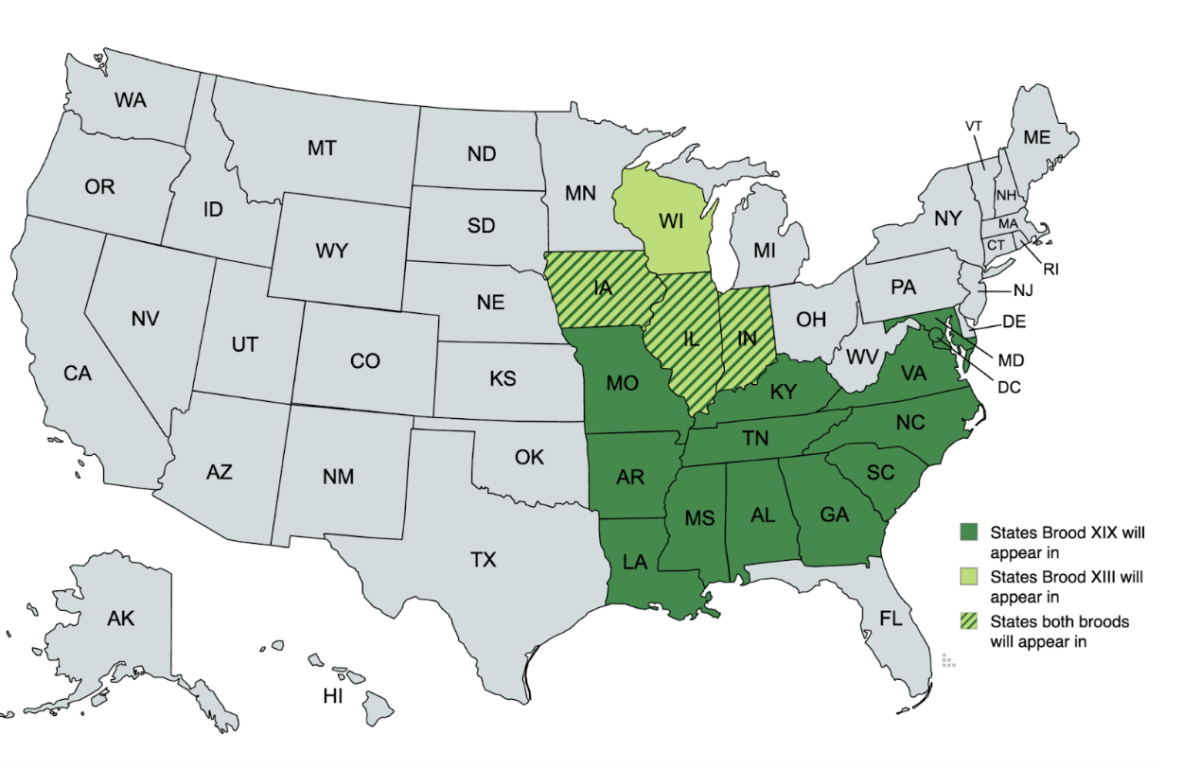High numbers and even higher noise–that’s the scene cicadas are anticipated to create this May across the midwestern and southeastern U.S., as this batch of busy bugs emerges from the ground after 13 years. How many cicadas the Northern Virginia area will see, however, is still in question.
Cicadas that come out of the ground together are referred to as “broods.” Brood XIX, also known as The Great Southern Brood, is one of the largest broods of cicadas in the United States, with a 13-year cycle. Together with Brood XIII, the cicadas of Brood XIX will make their way back to the sunlight after years of staying underground.
“What’s happening is that two broods are appearing in the Eastern United States, which hasn’t happened in hundreds of years,” environmental science teacher Anne Fenton said. “One of the things that’s so interesting for scientists is that because the two broods are so close, there’s the possibility that they’ll interbreed. Because two broods haven’t emerged [together] in a long time, scientists are going to have to wait a while to see what happens.”
While Brood XIII will only appear in Northern Illinois and other areas in the midwest, Brood XIX is projected to span 15 states—including parts of Virginia.
“It’s really interesting that only some parts of the U.S. get cicadas,” freshman Ruhan Movva said. “Since they’re going to pop up in areas with a lot of people, it will be really cool to see how it impacts life in those places.”
Evidence from 2011 showed that Brood XIX emerged in counties across southern Virginia. However, those earlier cicadas did not make a significant appearance in the Northern Virginia area.
“Even in 2021, the brood seen in Northern Virginia was kind of smaller than it should have been,” Fenton said. “Disturbed land also disturbs cicadas’ larvae stage, and it might prevent them from developing and hatching. Since we have lots of new housing and development that disturb the land around here, it might limit the extent to which we could really be seeing them.”
More recent research from earlier this year, however, shows that Brood XIX may emerge throughout much of eastern Virginia, as well as the outskirts of the Northern Virginia area this season. This is because, as cicadas remain underground for years, they can emerge in slightly different locations each new cycle.
“Cicadas dig their seeds in slightly different places from where they emerged each time,” Fenton said. “These slight displacements, when looked at from a larger scale with trillions of cicadas, can alter where they sprout up each new cycle.”
The possibility of encroachment by the bugs could create a potential nuisance for families, who may have to dig up dead cicadas in their backyards and hold on to their pets’ leashes a bit tighter. Past experiences also indicate that cicadas are known to cause physical damage to trees and plants, making it difficult for individuals to grow new shrubs in years preceding and during a cicada emergence.
“In 2004, the senior prank was that they gathered all these cicadas and stuffed them into lockers,” Fenton said. “It smelled bad, just like you would expect a whole bunch of dead insects to smell.“
Some students, however, are looking forward to the possibility of welcoming the buggy guests into the community this year.
“I was inside of my home during most of 2021 because of Covid, so I didn’t get to really hear them or even see what they sounded like,” sophomore Viv Dutt said. “These bugs don’t come in a lot of places or even come out most of the time either, so even if they might create some disturbance, the sight they’ll create will be worth it.”
No matter where the cicadas pop up this season, scientists say that late June to early July is the last time individuals will have the chance to see them in action before they begin to die off, after they’ve finished planting their heirs underground. It won’t be until 2037 when humanity sees the reign of Brood XIX make its grand entrance once again.
“They might be a bug that looks really strange and makes a lot of noise,” Movva said. “But, they’re still part of nature and deserve to live the way they need to.”









